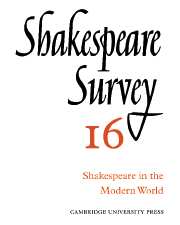Book contents
- Frontmatter
- An Obligation to Shakespeare and the Public
- Our Closeness to Shakespeare
- The Popularity of Shakespeare: An Examination of the Royal Shakespeare Theatre’s Repertory
- Shakespeare and the Fashion of These Times
- An Approach to Shakespearian Tragedy: The ‘Actor’ Image in Macbeth
- Shakespeare’s Impact Today in France
- Shakespeare and the Modern World
- Modern ‘Theatrical’ Translations of Shakespeare
- Shakespeare as ‘Corrupter of Words’
- Shakespeare in Ghana
- ‘Timon of Athens’
- Who Strutted and Bellowed?
- Shakespeare in Planché’s Extravaganzas
- ‘Our Will Shakespeare’ and Lope de Vega: An Unrecorded Contemporary Document
- Shakespeare and the Mask
- International Notes
- Shakespeare Productions in the United Kingdom: 1961
- Acting Shakespeare Today. A review of performances at the Royal Shakespeare Theatre, August 1962
- Canada’s Achievement
- 1 Critical Studies
- 2 Shakespeare’s Life, Times and Stage
- 3 Textual Studies
- Books Received
- Index
- Plate section
2 - Shakespeare’s Life, Times and Stage
Published online by Cambridge University Press: 28 March 2007
- Frontmatter
- An Obligation to Shakespeare and the Public
- Our Closeness to Shakespeare
- The Popularity of Shakespeare: An Examination of the Royal Shakespeare Theatre’s Repertory
- Shakespeare and the Fashion of These Times
- An Approach to Shakespearian Tragedy: The ‘Actor’ Image in Macbeth
- Shakespeare’s Impact Today in France
- Shakespeare and the Modern World
- Modern ‘Theatrical’ Translations of Shakespeare
- Shakespeare as ‘Corrupter of Words’
- Shakespeare in Ghana
- ‘Timon of Athens’
- Who Strutted and Bellowed?
- Shakespeare in Planché’s Extravaganzas
- ‘Our Will Shakespeare’ and Lope de Vega: An Unrecorded Contemporary Document
- Shakespeare and the Mask
- International Notes
- Shakespeare Productions in the United Kingdom: 1961
- Acting Shakespeare Today. A review of performances at the Royal Shakespeare Theatre, August 1962
- Canada’s Achievement
- 1 Critical Studies
- 2 Shakespeare’s Life, Times and Stage
- 3 Textual Studies
- Books Received
- Index
- Plate section
Summary
Although no comprehensive work has been published this year on Shakespeare’s biography, a number of articles deal with various aspects of Shakespeare the man. Certainly the most immediate is Frederick J. Pohl’s review of the evidence for thinking the Darmstadt death-mask to be genuine. After summarizing briefly the features in common and the relationship between the Stratford bust, and the Droeshout and Chandos portraits, Pohl examines critically the twenty-six comparative measurements of the bust and death-mask made by Paul Wislicensus in 1911. He discards a large number of them and concludes that the two representations have ten valid measurements in common which are ‘as much of proof as any reasonable person will require’ that the mask is authentic. In a pleasantly written essay, Herbert Howarth endeavours to see the man behind the mask by questioning what Jonson meant by ‘gentle’ when he applied it to Shakespeare. He suggests that Shakespeare would have been deeply influenced by his father’s attempt and failure to obtain a coat of arms, and traces the ways his own pretentions to ‘gentleness’ are manifest in the style of the poems and plays. Thus Venus and Adonis is a ‘deliberate first display of the gentle style’, and A Midsummer Night’s Dream the dramatic equivalent of it; the mature comedies show a movement from ‘the brilliance of courtliness to the charity of courtesy’, and the last plays a mastering of the toughness of the world by ‘the purest and most ecstatic gentleness’.
- Type
- Chapter
- Information
- Shakespeare Survey , pp. 164 - 172Publisher: Cambridge University PressPrint publication year: 1963



